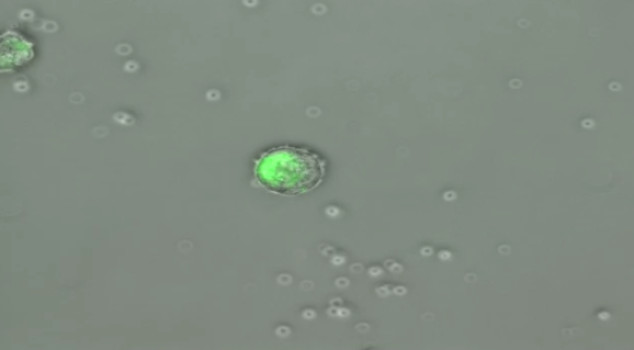
Researchers at the University of Cambridge have managed to reconstruct the early stage of mammalian development using embryonic stem cells, showing that a critical mass of cells — not too few, but not too many — is needed for the cells to being self-organising into the correct structure for an embryo to form.
All organisms develop from embryos: a cell divides generating many cells. In the early stages of this process, all cells look alike and tend to aggregate into a featureless structure, more often than not a ball. Then, the cells begin to ‘specialise’ into different types of cell and space out asymmetrically, forming an axis which begins to provide a structure for the embryo to develop along.
In animal embryos this stage is followed by a process known as gastrulation: a choreographed movement of the cells that, using the initial axis as a reference, positions the head and the tail, the front and the back. During the process, the cells begin to forum three distinct layers: the endoderm, mesoderm and ectoderm, determining which tissues or organs the cells will then develop into.
Professor Alfonso Martinez-Arias from the Department of Genetics at the University of Cambridge, who led the research, says: “Gastrulation was described by biologist Professor Lewis Wolpert as being ‘truly the most important event in your life’ because it creates the blueprint of an organism. Axis formation and gastrulation are the two central processes that initiate the development of an organism and are inextricably associated with the embryo. We have managed to recreate this for the first time in the lab.”
Professor Martinez-Arias and colleagues, supported by the European Research Council and the Wellcome Trust, have reconstructed these early stages of development using mouse embryonic stem cells. Embryonic stem cells, discovered in the Department of Genetics in the 1980s (for which Sir Martin Evans was awarded the Nobel Prize in Physiology or Medicine 2007), have become an important tool for developmental biology, understanding disease, and in regenerative medicine due to the ability to give rise to all cell types in culture. Over the last few years, they have been used to ‘grow’ organs including the eye and the cerebral cortex; surprisingly, these structures develop without an axis.
In research published today in the journal Development, the researchers report a way to coax cells to reorganize in the manner that they do in an embryo, creating an axis and undergoing movements and organisations that mimic the process of gastrulation. Over the years researchers have been making aggregates of embryonic stem cells to obtain certain cell types, for example red blood cells. However, these aggregates lack structure and the different cell types emerge in a disorganised fashion. This is the first time that researchers have been able to elicit axis formation, spatial organisation and gastrulation-like movements from aggregates of embryonic stem cells.
The researchers show that if the number of cells aggregated initially is similar to that of a mouse embryo, the cells generate a single axis and this serves as a template for a sequence of events that mimics those of the early embryo. By manipulating the signals that the cells see at a particular time, the researchers were able to influence what type of cell they become and how they are organised. In one of the experiments, for example, activation of a particular signal at the correct time elicits the appearance of the mesoderm, endoderm and ectoderm — the precursors of all cell types — with a spatial organization similar to that of an embryo.
Using this experimental system, the researchers were able to generate the early stages of a spinal cord, which they showed forms as part of the process of gastrulation. This finding complements previous research from the University of Edinburgh and the National Institute for Medical Research which showed that embryonic stem cells can be coaxed into this spinal cord cells; however, the Cambridge researchers showed that the in the embryo-like aggregates, the structural organization is more robust and allows for the polarised growth of the tissue.
Professor Martinez-Arias adds: “It is early days but this system promises insights into the early stages of development and what determines the specification of the different cell types. This will allow more robust protocols for differentiation with cues that mimic those that the cells are subject to in embryos.
“Most significantly, the system will provide a means to test, experimentally, how a homogeneous group of cells organizes itself in space, a central process in the development of any organism, and the ability to recreate in culture the niches that adult stem cells create during embryogenesis and which have remained elusive experimentally.”
Story Source:
The above story is based on materials provided by University of Cambridge. The original story is licensed under a Creative Commons Licence. Note: Materials may be edited for content and length.
Journal References:
- S. C. van den Brink, P. Baillie-Johnson, T. Balayo, A.-K. Hadjantonakis, S. Nowotschin, D. A. Turner, A. Martinez Arias. Symmetry breaking, germ layer specification and axial organisation in aggregates of mouse embryonic stem cells. Development, 2014; 141 (22): 4231 DOI: 10.1242/dev.113001
- D. A. Turner, P. C. Hayward, P. Baillie-Johnson, P. Rue, R. Broome, F. Faunes, A. Martinez Arias. Wnt/ -catenin and FGF signalling direct the specification and maintenance of a neuromesodermal axial progenitor in ensembles of mouse embryonic stem cells. Development, 2014; 141 (22): 4243 DOI: 10.1242/dev.112979
